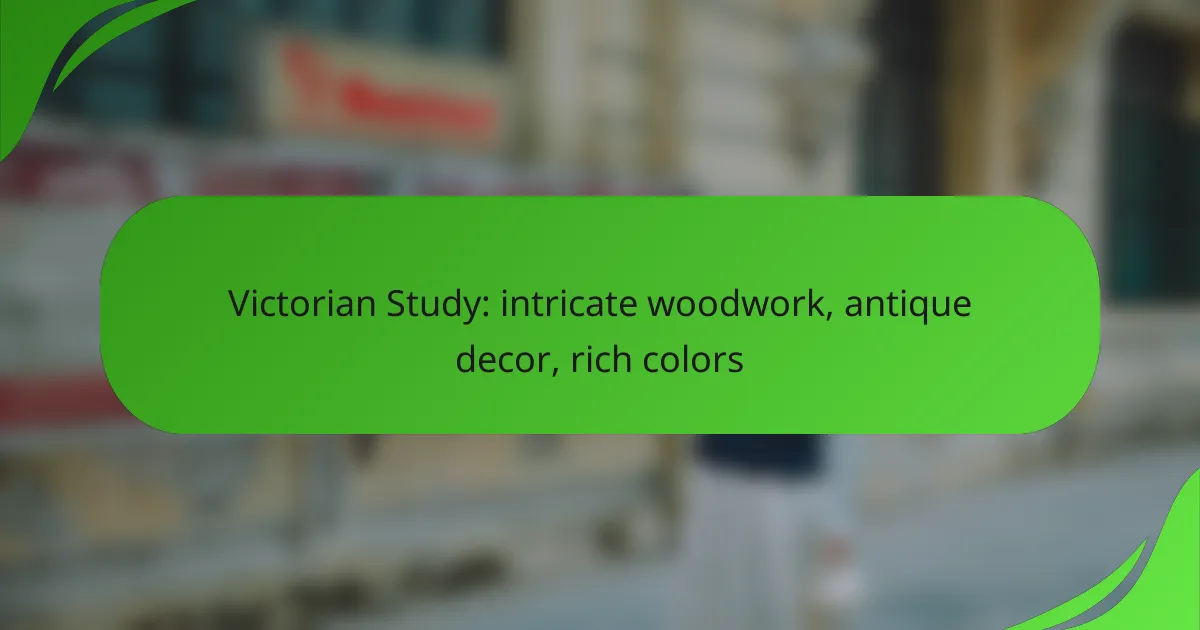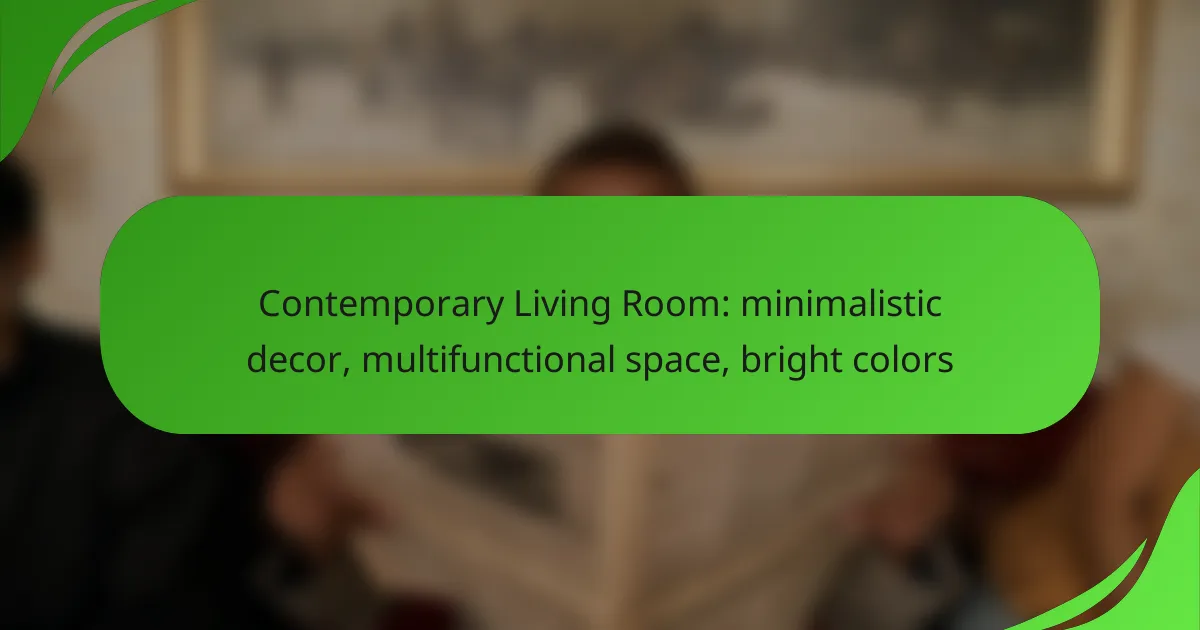The Victorian study is a celebration of intricate woodwork, rich colors, and antique decor that evokes a sense of historical elegance. This style emphasizes ornate craftsmanship and a layered design approach, creating inviting spaces that feel both luxurious and timeless. By incorporating authentic materials and vintage elements, one can seamlessly blend the charm of the past with modern sensibilities.

How to incorporate Victorian woodwork in modern design?
Incorporating Victorian woodwork into modern design involves blending ornate craftsmanship with contemporary aesthetics. Focus on using authentic materials, intricate details, and vintage elements to create a harmonious balance between old and new.
Use reclaimed wood for authenticity
Reclaimed wood adds genuine character and history to modern spaces. Sourcing wood from old buildings or furniture not only preserves the past but also promotes sustainability. Look for materials that showcase unique grains and weathered finishes to enhance the Victorian aesthetic.
When selecting reclaimed wood, consider its condition and suitability for your project. Ensure it is properly treated to prevent issues like pests or decay. Popular choices include oak, pine, and mahogany, which were commonly used in Victorian-era construction.
Choose intricate moldings and trims
Victorian design is characterized by elaborate moldings and trims that can elevate a modern interior. Opt for crown moldings, wainscoting, and baseboards with detailed patterns to introduce a touch of elegance. These elements can be painted in rich colors or left in natural wood finishes for added impact.
When incorporating moldings, pay attention to scale and proportion. Larger rooms can handle more intricate designs, while smaller spaces may benefit from simpler profiles. Always ensure that the moldings complement the overall style of the room.
Integrate vintage furniture pieces
Integrating vintage furniture pieces is a key aspect of achieving a Victorian-inspired look. Seek out items like tufted sofas, ornate chairs, and antique tables that reflect the craftsmanship of the era. These pieces can serve as focal points in a modern setting.
Mixing vintage with contemporary elements can create a unique aesthetic. For instance, pair a classic Victorian armchair with a minimalist coffee table to balance the old-world charm with modern simplicity. Be mindful of color schemes and materials to ensure cohesion throughout the space.

What are the key characteristics of Victorian decor?
Victorian decor is characterized by its intricate woodwork, rich colors, and a blend of antique furnishings that create a warm, inviting atmosphere. This style emphasizes ornate details and a layered approach to design, making spaces feel luxurious and historically rich.
Rich, dark color palettes
Victorian decor often features rich, dark color palettes that evoke a sense of opulence. Common colors include deep reds, greens, and browns, which can be used on walls, upholstery, and decorative accents. These hues create a dramatic backdrop that enhances the overall aesthetic.
When selecting colors, consider using a combination of jewel tones and muted shades to achieve depth. For instance, pairing a deep burgundy with a soft gold can create a striking yet harmonious look. Aim for a balance between bold and subtle to avoid overwhelming the space.
Heavy use of textiles and patterns
Textiles play a crucial role in Victorian decor, with heavy fabrics such as velvet, brocade, and damask commonly used for curtains, upholstery, and cushions. These materials add texture and warmth, contributing to the overall richness of the design.
Patterns are equally important, often featuring floral motifs, paisleys, and intricate damasks. Layering different patterns can create visual interest, but it’s essential to maintain a cohesive color scheme to prevent clashing. Mixing patterns can be effective when done thoughtfully, such as pairing a floral print with a striped fabric in complementary colors.
Emphasis on ornate details
Ornate details are a hallmark of Victorian decor, evident in the craftsmanship of furniture and architectural elements. Look for intricately carved woodwork, decorative moldings, and elaborate light fixtures that showcase artistry and attention to detail.
Incorporating these details can elevate a space, so consider investing in statement pieces like a carved mahogany sideboard or a chandelier with crystal accents. Be mindful of scale; large, ornate items can dominate a room, so balance them with simpler furnishings to maintain harmony.

Where to find antique Victorian decor?
Antique Victorian decor can be found in various places, including local shops, online platforms, and specialty auctions. Each option offers unique benefits and challenges, making it essential to explore multiple avenues to find the best pieces.
Local antique shops in London
London is home to numerous antique shops specializing in Victorian decor, where you can find intricate woodwork and rich colors. Areas like Portobello Road and Camden Market feature shops that often have unique items, from furniture to decorative pieces.
When visiting local antique shops, inspect items closely for authenticity and condition. Don’t hesitate to negotiate prices, as many shop owners expect some haggling.
Online marketplaces like eBay
eBay offers a vast selection of Victorian decor, allowing you to browse items from various sellers worldwide. You can find everything from small decorative items to larger furniture pieces, often at competitive prices.
When shopping on eBay, pay attention to seller ratings and item descriptions to avoid misrepresentations. Set alerts for specific searches to catch new listings quickly.
Specialty auctions for rare items
Specialty auctions can be an excellent source for rare Victorian decor, often featuring high-quality pieces that are hard to find elsewhere. Auction houses like Sotheby’s and Christie’s regularly hold events focused on antiques, providing access to exclusive items.
Before participating in an auction, research the items and set a budget to avoid overspending. Familiarize yourself with the auction process, including buyer’s premiums, to ensure a smooth experience.

What are the benefits of Victorian-style interiors?
Victorian-style interiors offer a unique blend of elegance and comfort, characterized by intricate woodwork, antique decor, and rich colors. These elements not only create a visually stunning environment but also evoke a sense of history and warmth.
Creates a warm, inviting atmosphere
Victorian interiors are known for their cozy and welcoming feel, often achieved through the use of deep, rich colors and plush furnishings. Dark woods and ornate details contribute to a sense of intimacy, making spaces feel more personal and inviting.
To enhance this atmosphere, consider using layered lighting with chandeliers, sconces, and table lamps that create soft, ambient light. Textiles such as velvet and brocade can further add warmth and comfort to the space.
Showcases craftsmanship and artistry
One of the hallmarks of Victorian design is its emphasis on craftsmanship and artistic detail. Intricate woodwork, such as moldings and carvings, reflects the skill of artisans and adds character to each piece of furniture and architectural feature.
When selecting items for a Victorian-style interior, prioritize pieces that showcase detailed craftsmanship, such as hand-carved furniture or decorative moldings. This not only enhances the aesthetic but also supports local artisans and sustainable practices.
Timeless aesthetic appeal
The Victorian style has a timeless quality that continues to resonate with many homeowners today. Its blend of elegance, comfort, and historical significance makes it a versatile choice that can adapt to modern needs while retaining its classic charm.
To maintain this aesthetic, focus on selecting decor that complements the Victorian theme, such as antique mirrors, vintage artwork, and period-appropriate accessories. Mixing in contemporary elements can create a fresh take while respecting the style’s roots.

How to choose colors for a Victorian-themed room?
Choosing colors for a Victorian-themed room involves selecting rich, saturated hues that reflect the opulence of the era. Focus on deep tones and complementary accents to create a warm and inviting atmosphere.
Opt for deep jewel tones
Deep jewel tones such as emerald green, sapphire blue, and ruby red are quintessential for a Victorian aesthetic. These colors evoke a sense of luxury and grandeur, making them ideal for walls, upholstery, and decorative elements.
When selecting jewel tones, consider using them on larger surfaces like walls or furniture to create a dramatic effect. Pairing these colors with lighter shades can help balance the overall look.
Incorporate gold or brass accents
Gold and brass accents add a touch of elegance and sophistication to a Victorian-themed room. These metallics can be introduced through fixtures, picture frames, or decorative hardware, enhancing the richness of the color palette.
To effectively use gold or brass, aim for a few standout pieces rather than overwhelming the space. A well-placed chandelier or ornate mirror can serve as a focal point that ties the room together.
Use contrasting light and dark shades
Contrasting light and dark shades can create depth and visual interest in a Victorian-themed room. For instance, pairing a dark wall color with lighter furniture or decor can highlight architectural features and add dimension.
Consider using light colors for trim, ceilings, or accent pieces to provide contrast against darker walls. This technique not only enhances the Victorian style but also helps to prevent the room from feeling too heavy or enclosed.

What are the maintenance tips for Victorian woodwork?
Maintaining Victorian woodwork involves regular care to preserve its intricate details and rich finish. Key practices include dusting, using suitable cleaners, and inspecting for wear to ensure longevity and aesthetic appeal.
Regular dusting and polishing
Regular dusting is essential for Victorian woodwork to prevent dirt buildup that can dull the finish. Use a soft, lint-free cloth or a feather duster to gently remove dust without scratching the surface.
Polishing should be done every few months using a high-quality furniture polish designed for wood. Apply it sparingly and buff with a clean cloth to enhance the wood’s natural luster.
Use appropriate wood cleaners
When cleaning Victorian woodwork, select cleaners specifically formulated for wood surfaces. Avoid harsh chemicals that can strip the finish or damage the wood.
For routine cleaning, a mixture of mild soap and water can be effective. Always test any cleaner on a small, inconspicuous area first to ensure it does not harm the finish.
Inspect for signs of wear
Regular inspections of your Victorian woodwork can help identify signs of wear, such as scratches, dents, or fading. Addressing these issues promptly can prevent further damage.
Look for areas where the finish may be wearing thin or where moisture has caused damage. If necessary, consider refinishing or touching up affected areas to maintain the woodwork’s beauty.









